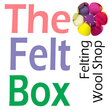Needles, Wool, Mistakes, Advice and the One Tip - Michelle Hayes from Michelle's Fancy Felts

1. How did you discover needle felting, what inspired you to have a go and what was the first thing you made?
I discovered needle felting during the last lockdown in March 2021. I was looking at my local WI’s list of online workshops and saw one about needle felting. I’d never heard of it before so started googling it. I ordered a kit and book and have been hooked ever since! The first thing I ever made was a set of penguins which had a polystyrene inner.
2. Do you have a favourite needle felting artists whose work you follow?There are so many inspiring needle felters around, I’ve learnt so much from Living felt and the Wooly Felters but my favourite is the Gentleman Felter.
3. Which projects do you find the trickiest and what has been the hardest thing to learn?I find making ‘pretty’ people the hardest, I find wizened old men and women much easier – it doesn’t matter so much if they have a wonky eye or a big nose!
4. What are your favourite needles to use?My most used needles are good old 38 triangles, and 40 triangles then I often finish off with a 40 spiral.
5. What is your favourite type of wool to work with?My favourite wool is the carded NZ wool from the Felt box. I find it felts beautifully and there is such a fab range of colours.
6. What is the worst piece of advice you keep hearing for needle felters?To use polystyrene for the inside of projects. It’s horrible and squeaky to work with plus it just disintegrates as you stab. I use core wool for the insides of all of my projects.
7. What common mistakes do people make when they start out?I made so many mistakes! My main one was not knowing the right kind of wool, I spent a fortune on beautiful wool which is actually tops, not carded wool, which is best for wet felting and takes an age to needle felt. Always buy carded for needle felting, unless you want something for hair and beards!
8. What is the one thing a beginner could learn today that would make a difference to their work?As a beginner, I struggled with getting the proportions right, particularly with faces. I then learnt to look at my project in terms of shapes – studying the distance between various parts and the sizes and breaking them down into a series of shapes to add together. Much like an artist or sculptor would do.
About the artist:You can find Michelle Hayes' work on:
Facebook - https://www.facebook.com/michellesfancyfelts
Or Instagram - @michellesfancyfelts
